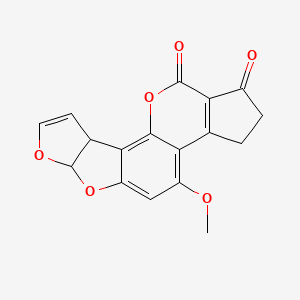AFBI
AFBI is a lipid of Polyketides (PK) class. Afbi is associated with abnormalities such as Pyotraumatic dermatitis, Infection, Hepatitis, Liver diseases and Hepatitis B. The involved functions are known as Immune response, Mutation, Anabolism, Metabolic Inhibition and Increased Sensitivy. Afbi often locates in Body tissue, Hepatic, Cytoplasm, Blood and Micronucleus. The associated genes with AFBI are TP53 gene, Genome, Transgenes, FATE1 gene and MANEA gene. The related lipids are Lipopolysaccharides, Lipid Peroxides, 1-(2-cyano-3,12-dioxooleana-1,9-dien-28-oyl) imidazole and Liposomes.
References related to functions published in Carcinogenesis
| PMID | Journal | Published Date | Author | Title |
|---|---|---|---|---|
| 10545423 | Carcinogenesis | 1999 | Wang SS et al. | Elevated HPRT mutation frequencies in aflatoxin-exposed residents of daxin, Qidong county, People's Republic of China. |
| 10190565 | Carcinogenesis | 1999 | Groisman IJ et al. | Downregulation of DNA excision repair by the hepatitis B virus-x protein occurs in p53-proficient and p53-deficient cells. |
| 15180943 | Carcinogenesis | 2004 | Bergès R et al. | Comparison of the chemopreventive efficacies of garlic powders with different alliin contents against aflatoxin B1 carcinogenicity in rats. |
| 17724371 | Carcinogenesis | 2007 | Peng T et al. | Evaluation of oxidative stress in a group of adolescents exposed to a high level of aflatoxin B1--a multi-center and multi-biomarker study. |
| 16000399 | Carcinogenesis | 2006 | van Herwaarden AE et al. | Breast cancer resistance protein (Bcrp1/Abcg2) reduces systemic exposure of the dietary carcinogens aflatoxin B1, IQ and Trp-P-1 but also mediates their secretion into breast milk. |
| 16829687 | Carcinogenesis | 2006 | Pokharel YR et al. | Potent protective effect of isoimperatorin against aflatoxin B1-inducible cytotoxicity in H4IIE cells: bifunctional effects on glutathione S-transferase and CYP1A. |
| 16679307 | Carcinogenesis | 2006 | Kirk GD et al. | Molecular epidemiology of human liver cancer: insights into etiology, pathogenesis and prevention from The Gambia, West Africa. |
